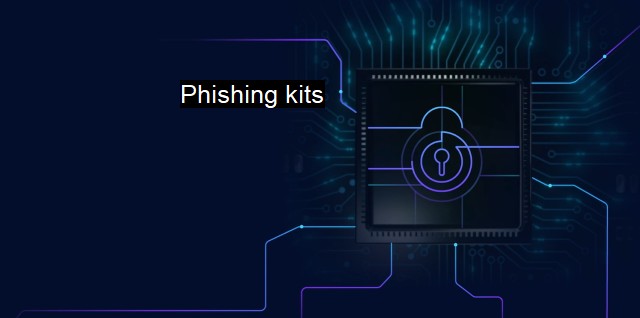What are Phishing kits?
Unveiling Phishing Kits: The Menace Behind Cyber Attacker's Strategy to Steal Your Sensitive Data
Phishing kits represent a growing threat within the global cybersecurity landscape, exploited by a variety of perpetrators ranging from individual hackers to state-sponsored operatives. By definition, a phishing kit is a collection of thousands of software utilities that can be exploited to create scalable, efficient, and targeted phishing campaigns. These campaigns aim to steal personal and financial data from individuals and organizations, damaging reputations, wreaking financial havoc, and often violacting customer privacy to an untold degree.Phishing kits essentially act as ready-made tools for deceiving recipients into exposing sensitive data, typically by offering malicious links or attachments. The sophistication of these kits can vary, with some being designed as pure turnkey solutions, perfect for less tech-savvy criminals who wouldn't have the technical acumen to write their workable phishing code. More sophisticated kits provide versatile, customizable platforms that enable attackers to amplify their malicious campaigns, hone their targets and optimize their returns.
The terrifying aspect of these kits is the sheer ease and affordability of acquisition. They're usually easy to procure from the dark corners of the internet and usually at an affordable rate. While no actual price can be given due to the constant flux of this illicit marketplace, it’s sufficient to say that barrier to entry for phishing attacks has been dramatically lowered by the availability of these kits. Equally important, a single successful exploit can counterbalance the initial cost manifold.
Many phishing kits mimic recognizable applications or services to wrong foot unsuspecting users or employees. Amazon, Facebook, Office 365, and PayPal are common themes, further lending an air of legitimacy to the phishing emails or links sent out. these kits will often include a range of secondary features, such as mass mailing functionality or web control panels, to facilitate the creation and management of malicious campaigns.
Phishing kits also present a challenge for traditional antivirus security measures. Malware can often be identified and quarantined based on recognizable, malicious code. But these kits primarily trade on deception rather than explicit system manipulation, essentially bribing users to volunteer their sensitive data. As a result, standard antivirus measures – built to discern and interrupt suspicious system activity – can often fail to pick up on phishing attacks.
Anti-phishing AI tools are increasingly being integrated into antivirus solutions to contend with the threat of phishing kits. These AI elements practice pattern recognition, identifying potential threats and offensive behavior over time, involving contextual and predictive analytics. This weaponry, combined with increased and continued vigilance on the part of organizations and end-users, plays a crucial role in combatting the cybersecurity threats posed by phishing kits.
Phishing kits demonstrate a sinister maturation in the already ominous world of cybercrime; offering the same potential returns, through identity theft and financial misappropriation, for a fraction of technical acumen or effort traditionally required. While the theft method relies on trickery and deceit, rather than more flashy hacks or clear malware, the potential consequences for business and individual computer users are just as serious, if not more so. As such, adequate defenses against phishing kits necessitate a two-pronged response, combining tech-savvy solutions such as AI-supported antivirus software with an ingrained culture of security awareness and vigilance within organizations or networks.

Phishing kits FAQs
What are phishing kits?
Phishing kits are a collection of tools and resources used by cybercriminals to create and launch phishing attacks. These kits make it easier for criminals to create convincing fake websites, emails or other types of messages that trick unsuspecting users into divulging sensitive information.How do cybercriminals use phishing kits to attack users?
Cybercriminals use phishing kits to send out convincing fake emails that appear to be from legitimate sources such as banks, social media sites or e-commerce platforms. The emails usually contain a link to a fake website that looks exactly like the real one, but is designed to capture the user's login credentials or other sensitive information. Once the user enters their information, cybercriminals can use it to gain access to their accounts or steal their identity.How can antivirus software protect users from phishing kits?
Antivirus software can protect users from phishing kits by detecting and blocking suspicious emails, websites or other types of messages that may contain malware or other malicious code. Some antivirus software solutions also offer additional security features such as anti-phishing protection, which can identify and block fake websites or emails that try to steal user data.What can users do to protect themselves from phishing attacks?
Users can protect themselves from phishing attacks by being vigilant and cautious when receiving unsolicited emails or messages. They should always check the URL of the website they are about to log in to, and make sure it is spelled correctly and that the site is secure. They should also avoid clicking on links or downloading attachments from suspicious emails, and never provide personal or sensitive information unless they are absolutely sure of the legitimacy of the request. Regularly updating and using antivirus software and keeping all software up to date can also help protect against phishing attacks.| | A | | | B | | | C | | | D | | | E | | | F | | | G | | | H | | | I | | | J | | | K | | | L | | | M | |
| | N | | | O | | | P | | | Q | | | R | | | S | | | T | | | U | | | V | | | W | | | X | | | Y | | | Z | |
| | 1 | | | 2 | | | 3 | | | 4 | | | 7 | | | 8 | | |||||||